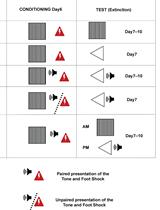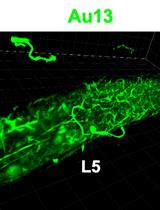- EN - English
- CN - 中文
Contusion Spinal Cord Injury Rat Model
挫伤脊髓损伤大鼠模型
发布: 2017年06月20日第7卷第12期 DOI: 10.21769/BioProtoc.2337 浏览次数: 12288
评审: Soyun KimQing YanAnonymous reviewer(s)

相关实验方案

基于 rAAV-α-Syn 与 α-Syn 预成纤维共同构建的帕金森病一体化小鼠模型
Santhosh Kumar Subramanya [...] Poonam Thakur
2025年12月05日 1388 阅读
Abstract
Spinal cord injury (SCI) can lead to severe disability, paralysis, neurological deficits and even death. In humans, most spinal cord injuries are caused by transient compression or contusion of the spinal cord associated with motor vehicle accidents. Animal models of contusion mimic the typical SCI’s found in humans and these models are key to the discovery of progressive secondary tissue damage, demyelination, and apoptosis as well as pathophysiological mechanisms post SCI. Here we describe a method for the establishment of an efficient and reproducible contusion model of SCI in adult rat.
Keywords: Spinal cord injury (脊髓损伤)Background
The spinal cord plays an important role in the interconnections between the brain and peripheral nerves. Severe SCI causes the loss of physiological functions and even paralysis or death (Singh et al., 2014). After SCI, the microvascular hemorrhage with disruption of the blood-spinal cord barrier is followed by edema, ischemia, and the release of cytotoxic chemicals from inflammatory pathways (Oyinbo, 2011; Mothe and Tator, 2012). Secondary neurodegenerative events such as demyelination, Wallerian degeneration and axonal dieback occur in the non-permissive tissue environment. Contusion, a type of blunt injury in the spinal cord, mimics typical SCI in humans which is mainly caused by vehicle accidents, especially motorcycles. In contrast to the sharp SCI model such as the transection that provides an anatomical model for evaluating axonal regeneration, the contused spinal cord presents a preferable microenvironment for studying of pathophysiological mechanisms post injury (Young, 2002). Experimental induction of a contusive SCI in a rat model using the NYU-MASCIS (New York University-Multicenter Animal Spinal Cord Injury Study) impactor device has been validated as an analog to human SCI. Furthermore, a comparison between the rat model of SCI with human SCI shows functional electrophysiological and morphological evidence of similar patterns recorded in motor evoked potentials and somatosensory evoked potentials (SSEP) as well as high-resolution magnetic resonance imaging (Basso et al., 1996; Metz et al., 2000; Kwon et al., 2002; Young, 2002). Here we describe a method with tips for construction of an efficient and reproducible contusion model of SCI in adult rat.
Materials and Reagents
- Surgical blade #21 (DIMEDA Instrumente, catalog number: 06.121.00 )
- Chromic catgut (4/0) (UNIK, catalog number: CT134 )
- Nylon suture (3/0) (UNIK, catalog number: NC203 )
- Adult female Sprague Dawley (SD) rat (225-250 g)
- Isoflurane (Halocarbon Laboratories, NDC12164-002-25 )
- 0.9% saline solution (TAI YU CHEMICAL & PHARMACEUTICAL, catalog number: RH1704 )
- Povidone-iodine solution (YING YUAN CHEMICAL PHARMACEUTICAL, catalog number: S-166 )
- Acetaminophen solution (CENTER Laboratories, catalog number: 19746 )
- Luxol fast blue stain kit (Abcam, catalog number: ab150675 )
- Hematoxylin and Eosin Stain Kit (Vector Laboratories, catalog number: H-3502 )
- Trimethoprim-sulfamethoxazole pre-mixed antibacterial solution (YUNG SHIN PHARM, catalog number: TRI-004 )
- Trimethoprim-sulfamethoxazole antibacterial injectable working solution (see Recipes)
Equipment
- NYU-MASCIS weight-drop impactor with an alligator and the software
- 2.5 mm tip of impactor for rat
- Scalpel handle #4 (DIMEDA Instrumente, catalog number: 06.104.00 )
- Heating pad
- Adson toothed forceps (DIMEDA Instrumente, catalog number: 10.180.12 )
- ALM self-retaining retractor (DIMEDA Instrumente, catalog number: 18.620.07 )
- MAYO HEGAR needleholder (DIMEDA Instrumente, catalog number: 24.180.16 )
- Littauer bone cutter (Stoelting, catalog number: 52167-80P )
- Operating scissors (Shinetech, catalog number: ST-S114PK )
- CMA/150 Temperature controller (CMA Microdialysis, model: CMA 150 , catalog number: 600)
- Dry sterilizer (Braintree Scientific, model: Germinator 500 , catalog number: GER 5287-120V)
- Surgical microscope (Carl Zeiss, model: Zeiss Stativ S3 )
- Table top anesthesia system (AM Bickford, catalog number: 61020 )
- EVA soft foam mat (Lee Chyun Enterprise, model: FM 600T )
Software
- MAS 7.0 version
- Microsoft Windows 98 operating system
Procedure
文章信息
版权信息
© 2017 The Authors; exclusive licensee Bio-protocol LLC.
如何引用
Chiu, C., Cheng, H. and Hsieh, S. E. (2017). Contusion Spinal Cord Injury Rat Model. Bio-protocol 7(12): e2337. DOI: 10.21769/BioProtoc.2337.
分类
神经科学 > 神经系统疾病 > 动物模型
您对这篇实验方法有问题吗?
在此处发布您的问题,我们将邀请本文作者来回答。同时,我们会将您的问题发布到Bio-protocol Exchange,以便寻求社区成员的帮助。
Share
Bluesky
X
Copy link










